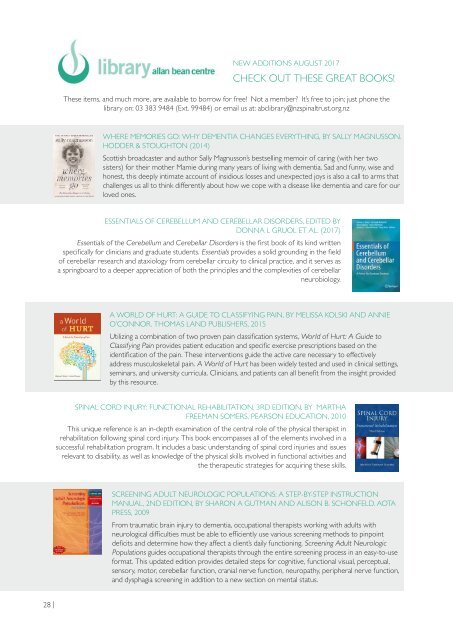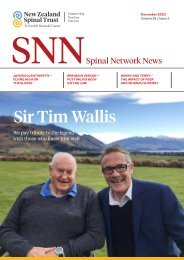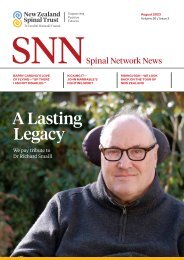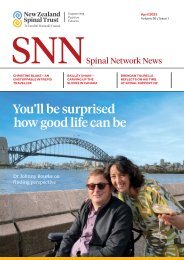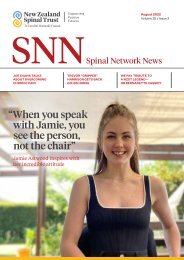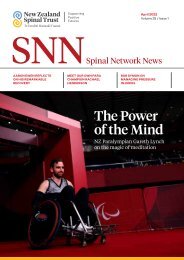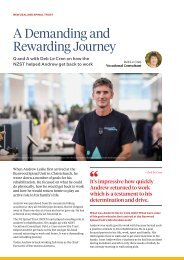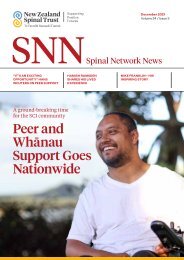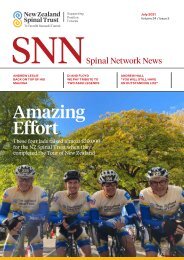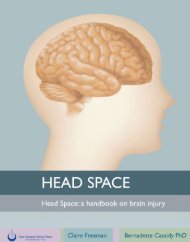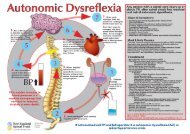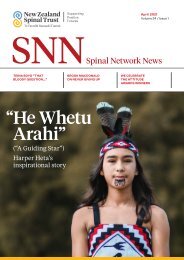Spinal Network News - August 2017
You also want an ePaper? Increase the reach of your titles
YUMPU automatically turns print PDFs into web optimized ePapers that Google loves.
NEW ADDITIONS AUGUST <strong>2017</strong><br />
CHECK OUT THESE GREAT BOOKS!<br />
These items, and much more, are available to borrow for free! Not a member? It’s free to join; just phone the<br />
library on: 03 383 9484 (Ext. 99484) or email us at: abclibrary@nzspinaltrust.org.nz<br />
WHERE MEMORIES GO: WHY DEMENTIA CHANGES EVERYTHING, BY SALLY MAGNUSSON.<br />
HODDER & STOUGHTON (2014)<br />
Scottish broadcaster and author Sally Magnusson’s bestselling memoir of caring (with her two<br />
sisters) for their mother Mamie during many years of living with dementia. Sad and funny, wise and<br />
honest, this deeply intimate account of insidious losses and unexpected joys is also a call to arms that<br />
challenges us all to think differently about how we cope with a disease like dementia and care for our<br />
loved ones.<br />
ESSENTIALS OF CEREBELLUM AND CEREBELLAR DISORDERS, EDITED BY<br />
DONNA L GRUOL ET AL. (<strong>2017</strong>)<br />
Essentials of the Cerebellum and Cerebellar Disorders is the first book of its kind written<br />
specifically for clinicians and graduate students. Essentials provides a solid grounding in the field<br />
of cerebellar research and ataxiology from cerebellar circuity to clinical practice, and it serves as<br />
a springboard to a deeper appreciation of both the principles and the complexities of cerebellar<br />
neurobiology.<br />
A WORLD OF HURT: A GUIDE TO CLASSIFYING PAIN, BY MELISSA KOLSKI AND ANNIE<br />
O’CONNOR. THOMAS LAND PUBLISHERS, 2015<br />
Utilizing a combination of two proven pain classification systems, World of Hurt: A Guide to<br />
Classifying Pain provides patient education and specific exercise prescriptions based on the<br />
identification of the pain. These interventions guide the active care necessary to effectively<br />
address musculoskeletal pain. A World of Hurt has been widely tested and used in clinical settings,<br />
seminars, and university curricula. Clinicians, and patients can all benefit from the insight provided<br />
by this resource.<br />
SPINAL CORD INJURY: FUNCTIONAL REHABILITATION, 3RD EDITION, BY MARTHA<br />
FREEMAN SOMERS. PEARSON EDUCATION, 2010<br />
This unique reference is an in-depth examination of the central role of the physical therapist in<br />
rehabilitation following spinal cord injury. This book encompasses all of the elements involved in a<br />
successful rehabilitation program. It includes a basic understanding of spinal cord injuries and issues<br />
relevant to disability, as well as knowledge of the physical skills involved in functional activities and<br />
the therapeutic strategies for acquiring these skills.<br />
SCREENING ADULT NEUROLOGIC POPULATIONS: A STEP-BY-STEP INSTRUCTION<br />
MANUAL, 2ND EDITION, BY SHARON A GUTMAN AND ALISON B. SCHONFELD. AOTA<br />
PRESS, 2009<br />
From traumatic brain injury to dementia, occupational therapists working with adults with<br />
neurological difficulties must be able to efficiently use various screening methods to pinpoint<br />
deficits and determine how they affect a client’s daily functioning. Screening Adult Neurologic<br />
Populations guides occupational therapists through the entire screening process in an easy-to-use<br />
format. This updated edition provides detailed steps for cognitive, functional visual, perceptual,<br />
sensory, motor, cerebellar function, cranial nerve function, neuropathy, peripheral nerve function,<br />
and dysphagia screening in addition to a new section on mental status.<br />
28 |


